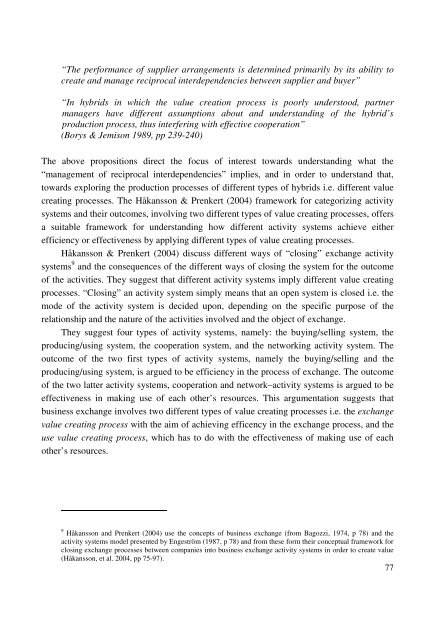Value Co-Creation in Industrial Buyer-Seller Partnerships ... - Doria
Value Co-Creation in Industrial Buyer-Seller Partnerships ... - Doria
Value Co-Creation in Industrial Buyer-Seller Partnerships ... - Doria
- No tags were found...
You also want an ePaper? Increase the reach of your titles
YUMPU automatically turns print PDFs into web optimized ePapers that Google loves.
“ The performance of supplier arrangements is determ<strong>in</strong>ed primarily by its ability tocreate and manage reciprocal <strong>in</strong>terdependencies between supplier and buyer”“ In hybrids <strong>in</strong> which the value creation process is poorly understood, partnermanagers have different assumptions about and understand<strong>in</strong>g of the hybrid’sproduction process, thus <strong>in</strong>terfer<strong>in</strong>g with effective cooperation”(Borys & Jemison 1989, pp 239-240)The above propositions direct the focus of <strong>in</strong>terest towards understand<strong>in</strong>g what the“ management of reciprocal <strong>in</strong>terdependencies” implies, and <strong>in</strong> order to understand that,towards explor<strong>in</strong>g the production processes of different types of hybrids i.e. different valuecreat<strong>in</strong>g processes. The Håkansson & Prenkert (2004) framework for categoriz<strong>in</strong>g activitysystems and their outcomes, <strong>in</strong>volv<strong>in</strong>g two different types of value creat<strong>in</strong>g processes, offersa suitable framework for understand<strong>in</strong>g how different activity systems achieve eitherefficiency or effectiveness by apply<strong>in</strong>g different types of value creat<strong>in</strong>g processes.Håkansson & Prenkert (2004) discuss different ways of “ clos<strong>in</strong>g” exchange activitysystems 9 and the consequences of the different ways of clos<strong>in</strong>g the system for the outcomeof the activities. They suggest that different activity systems imply different value creat<strong>in</strong>gprocesses. “ Clos<strong>in</strong>g” an activity system simply means that an open system is closed i.e. themode of the activity system is decided upon, depend<strong>in</strong>g on the specific purpose of therelationship and the nature of the activities <strong>in</strong>volved and the object of exchange.They suggest four types of activity systems, namely: the buy<strong>in</strong>g/sell<strong>in</strong>g system, theproduc<strong>in</strong>g/us<strong>in</strong>g system, the cooperation system, and the network<strong>in</strong>g activity system. Theoutcome of the two first types of activity systems, namely the buy<strong>in</strong>g/sell<strong>in</strong>g and theproduc<strong>in</strong>g/us<strong>in</strong>g system, is argued to be efficiency <strong>in</strong> the process of exchange. The outcomeof the two latter activity systems, cooperation and network–activity systems is argued to beeffectiveness <strong>in</strong> mak<strong>in</strong>g use of each other’ s resources. This argumentation suggests thatbus<strong>in</strong>ess exchange <strong>in</strong>volves two different types of value creat<strong>in</strong>g processes i.e. the exchangevalue creat<strong>in</strong>g process with the aim of achiev<strong>in</strong>g efficency <strong>in</strong> the exchange process, and theuse value creat<strong>in</strong>g process, which has to do with the effectiveness of mak<strong>in</strong>g use of eachother’ s resources.9 Håkansson and Prenkert (2004) use the concepts of bus<strong>in</strong>ess exchange (from Bagozzi, 1974, p 78) and theactivity systems model presented by Engeström (1987, p 78) and from these form their conceptual framework forclos<strong>in</strong>g exchange processes between companies <strong>in</strong>to bus<strong>in</strong>ess exchange activity systems <strong>in</strong> order to create value(Håkansson, et al. 2004, pp 75-97).77
















